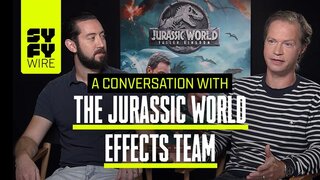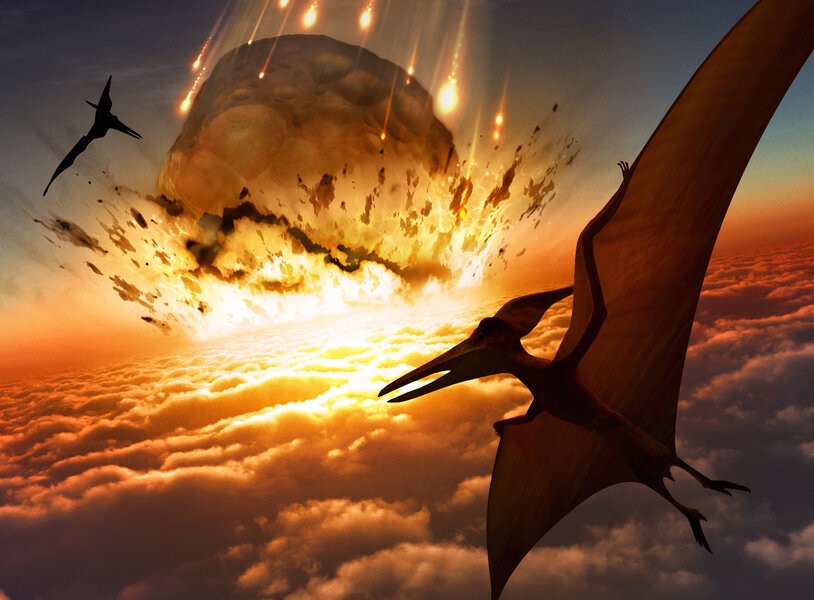Create a free profile to get unlimited access to exclusive videos, sweepstakes, and more!
A 2-Year Global Dust Cloud Is the Latest Suspect in the Extinction of the Dinosaurs
The asteroid threw a dimmer switch on the whole planet.
Human civilization and the rest of the modern world is built on a massive planet-sized dinosaur graveyard. John Hammond (Richard Attenborough) and his mad scientists at InGen did what they could to rob that grave of its genetic treasures in Jurassic Park and its sequels. Yet, even though they succeeded at bringing dinosaurs (or something like them) back to life, they couldn’t know what really wiped them out in the first place. Solving that mystery can only be done through painstaking paleontological research.
Now, a new study published in the journal Nature Geosciences has uncovered one of the saurian assassins in the form of a sunlight-blocking dust cloud which halted photosynthesis for two years.
Dinosaur-Killing Asteroid Thrust Earth into a Literal Dark Age
Most school-aged kids know what happened to the dinosaurs, at least the broad strokes anyway. Once upon a time, tens of millions of years ago, a vast diversity of dinosaurs roamed the Earth. They had complex social structures, they cared for their babies, and some of them were probably pretty smart, on the level of some modern birds. Which shouldn’t be that surprising, considering that birds are themselves, dinosaurs.
RELATED: If Dinosaurs Went Extinct, Why Are There Still Birds?
Then an asteroid the size of a small city struck the Earth and the party ended. We know from the fossil record that a cosmic sucker punch of that scale – leaving a crater 112 miles (180 kilometers) wide – disrupted the ecosystem enough that roughly three quarters of all species died out. The precise mechanism of extinction, however, is less clear. Over the years, research has suggested that the impact kicked off volcanic eruptions which dumped sulfur into the atmosphere and cooled the planet, leading to a global winter which lasted years. Others have suggested that the impact kicked literal tons of material up into space before it rained back down, heating the air and cooking terrestrial life in an oven the size of a planet.
The new study relies on analysis of sediments collected at the Tanis site in North Dakota to show that a global dust cloud likely played a big part in the demise of most life on Earth 66 million years ago. At Tanis, scientists found a significant store of small dust grains likely created by the impact. Interpretation of their findings suggests that the asteroid came in with such speed and force that the rock where it landed was pulverized and thrust up into the atmosphere. All of that dust, combined with soot from raging wildfires all over the world, flooded the atmosphere for up to 15 years after the impact.
Researchers simulated the environmental impact of that much dust on the wider world and found that the dust would have blocked out the Sun enough to halt photosynthesis entirely for almost two years. In addition to the other challenges of a post-impact world, the food web would have totally collapsed. In the absence of photosynthesis, plants died out. Herbivores suddenly found that their once rich stores of food had vanished, and they starved. Predators, reliant on herbivores for prey, starved as well. Only a couple of animal types managed to survive on the leavings of a catastrophically wounded world.
RELATED: Dinosaur killing asteroid triggered a mile-high tsunami
Scavengers persist, feeding on the growing smorgasbord of carrion, hoping to eke it out long enough for the Sun to return. Small animals like our own ancestors capable of hiding out in burrows managed to make it through. And some of the avian dinosaurs (the ancestors of modern birds) adapted to live off of seeds and nuts, themselves well-adapted to survive the harsh conditions of a changing world, survived as well.
Our world, of course, is a sunlight-powered economy. Sunlight is the engine that makes the whole thing work and without plants to photosynthesize and turn sunlight into eatable stuff, the whole system falls apart. Fortunately, the dust settled, and air cleared quickly enough for life to keep a foothold and for us, eventually, to evolve and figure it out.
See a more modern dinosaurian apocalypse for yourself in Jurassic World: Fallen Kingdom, streaming now on Peacock.































